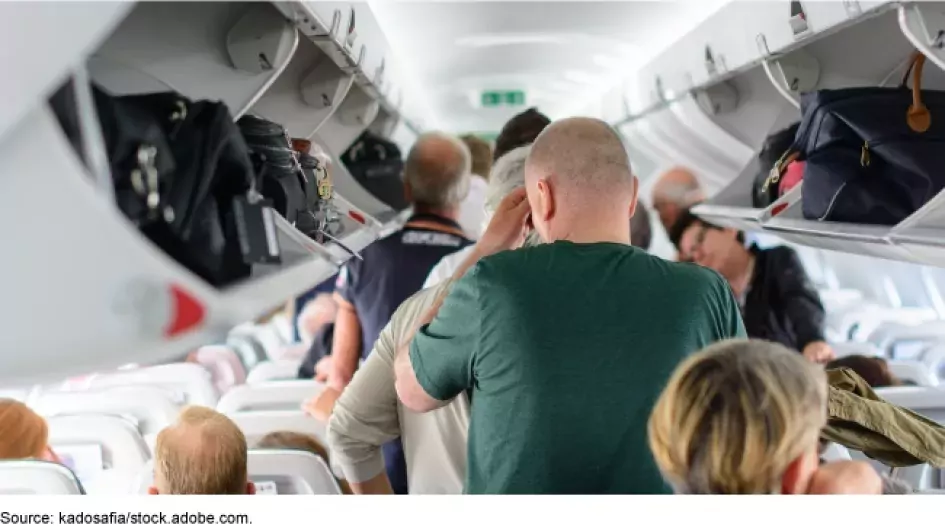Flying This Holiday Season? Here’s What to Expect
Flying during the last few holiday seasons hasn’t been anyone’s idea of fun. Along with the usual hustle and bustle of crowded airports and luggage mishaps, passengers had to deal with COVID-related flight delays and cancellations, health concerns, and shifting safety requirements.
While the release of a booster for the omicron variant and a reduction in hospitalizations may have put some passengers more at ease, others are still balancing COVID concerns with the desire to toast the holidays in person. Federal agencies have taken some steps to help understand how diseases like COVID can be spread through air travel, and to stop them.
Today’s WatchBlog post looks at our recent work on these efforts and ways to improve them.
Image

Masking requirements changed
This year, travelers may see fewer masks at the airport, as they are no longer mandatory on international or domestic flights or in U.S. airports. Still, wearing a mask, getting vaccinated, and taking a few other precautions may provide some protection from COVID-19 and other communicable diseases.
In a recent report, we looked at how communicable diseases spread on airplanes. Our review of existing research found that certain behaviors can increase your risks. For example, you might be at higher risk if you wear your face mask improperly or spend time in poorly ventilated spaces. But there is still much that is not known about how diseases spread in this environment, and how best to protect passengers and crew.
Image

While several federal agencies have supported research related to communicable diseases in air travel, this research has focused on areas most relevant to the agencies’ priorities. No agency has taken steps to advance research on communicable diseases in air travel more broadly or coordinate federal efforts to fill in gaps in knowledge. Stakeholders said there is a particular need for more research involving real-world situations and human behavior.
For example, much of the research on disease transmission on aircraft has involved static dummies or mathematical models, rather than real humans that move around the aircraft cabin.
In July, we asked Congress to direct the Federal Aviation Administration (FAA) to work with its federal partners on developing a research strategy for communicable diseases in air travel. Doing so is an important step toward protecting passengers from COVID-19 and any future disease outbreaks.
What happens if I get sick while travelling?
If you do end up being exposed to disease on a flight, what happens next?
The Centers for Disease Control and Prevention (CDC) plays a key role in working with airlines to identify passengers who may have come into contact with a person infected with a communicable disease. CDC shares this information with local public health authorities, which notify passengers who were potentially exposed, and advises them of steps to help stop the spread and keep their communities safe.
However, we found several factors that impair CDC’s ability to trace COVID and other communicable diseases and then ensure that passengers who may have been exposed are notified in a timely fashion. For example, there is no single reliable source of passenger information. When information is missing, like a passenger’s phone number, there could be a delay in notifying that person of potential exposure.
CDC has taken some steps to collect more complete, accurate, and timely information. For example, it has begun requiring airlines to collect certain information—such as name, phone number, and email address—from passengers travelling into the U.S. no more than 72 hours before departure.
However, we found CDC uses an outdated system which does not allow the agency to quickly and accurately identify the number of individuals exposed to an infected passenger on a flight. We recommended CDC redesign its current data management system or develop a new one, to better protect public health.
To learn more about federal efforts to prevent the spread of communicable diseases in air travel, listen to our recent podcast with GAO’s Heather Krause, an aviation industry expert.
What happens if your flight gets canceled?
While we’re wishing everyone a safe, smooth, and—dare we say it—enjoyable journey this holiday season, here’s what you should know if your flight gets canceled.
A passenger is entitled to a refund if the airline cancels a flight, regardless of the reason. The Department of Transportation (DOT) provides information on aviation consumer protections on its website, and has a new dashboard for understanding what airlines offer when flights are canceled.
- Comments on GAO’s WatchBlog? Contact blog@gao.gov.
GAO Contacts
Related Products

GAO's mission is to provide Congress with fact-based, nonpartisan information that can help improve federal government performance and ensure accountability for the benefit of the American people. GAO launched its WatchBlog in January, 2014, as part of its continuing effort to reach its audiences—Congress and the American people—where they are currently looking for information.
The blog format allows GAO to provide a little more context about its work than it can offer on its other social media platforms. Posts will tie GAO work to current events and the news; show how GAO’s work is affecting agencies or legislation; highlight reports, testimonies, and issue areas where GAO does work; and provide information about GAO itself, among other things.
Please send any feedback on GAO's WatchBlog to blog@gao.gov.




